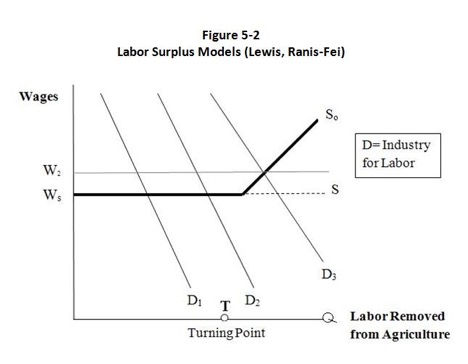| << Chapter < Page | Chapter >> Page > |
And as we see in Chapter___ foreign savings is split into two parts:
Another simple model of economic growth and development that strongly affected thinking was the 2-sector Ranis-Fei Model. This was a concept of economic development based on unlimited supplies of labor. In the sixties and seventies this model also enjoyed very wide currency among economist and policy-makers especially in Africa and India.
To be sure, in the sixties the model was most appropriate to poor nations with large agricultural sectors (where agriculture was greater than 50% of GDP). Note in 2008 U.S. agriculture was 2% of GDP. The Ranis-Fei approach builds on a 1955 contribution by W. Arthur Lewis, which in turn was based on the work of classical economist David Ricardo in 1820. So the intellectual lineage of Ranis Fei was Ricardo and Lewis.
The principal labor surplus models can be depicted as in Figure 5-2. Real wages remain constant and labor supply is constant until enough labor is removed from agriculture by growing demand for labor (from D 1 , to D 2 to D 3 ). A turning point is ultimately reached, at T in Figure 5-2.

In Figure 5-2
To recapitulate, Arthur Lewis presented a two-sector model which depicted economic development with unlimited supplies of labor, or at least, continuing labor surpluses. This assumes continued rapid growth in population. Gustav Ranis and John Fei at Yale extended Lewis’ model in a book: Development of the Labor Surplus Economy . They focused upon the relationship between industry and agriculture in conditions of labor surplus with an exogenously determined subsistence wages. Both the Lewis and Ranis-Fei models postulated a perfectly elastic supply (horizontal) curve for labor in agriculture, up to the point where labor’s marginal product in agriculture rises above the subsistence wage.
The implications of these 50s and 60s vintage models were taken quite seriously in their day. How useful might they be for the 21st century say for China before 2008?
The Ranis-Fei model predicted rather dire consequences for real wages both in industry and agriculture. Note that the model assumes population rises steadily forever. However, when population growth slows, drawing labor out of agriculture will eventually drive up real wages in both agriculture and industry. Ranis-Fei type models were somewhat helpful in certain conditions. And, in China in the 60s and 70s, population was still growing notably in 60s, and most arable land was already being cultivated. Adding growing amounts of labor to fixed supply of land-leads to diminishing return and thus falling marginal product (MP). In China, labors MP was very low. Under these conditions increases in population and increases in labor force in agriculture added little to total agricultural output, just as predicted in the Lewis and Ranis-Fei constructs. Urban wages in China—read industrial wages—did rise a bit in the early 50s . But then urban labor experienced limited gains for two decades until 1977. In those two decades, tens of millions of agricultural workers attempted to migrate to the cities, even in the presence of stagnation in industrial wages. However , they were prevented from doing so by legal constraints on rural to urban migration, (especially by the rise of internal passports). With 2 % per annum population growth until the mid-70s , labor surpluses in the Chinese country continued to grow so that the agricultural labor force then accounted for a staggering 71% of total employment , compared to the U.S., where about 4% of labor force worked in agriculture in the late 20th century. At the same time, there was somewhat surprisingly, a small shift in the rural-urban terms of trade in favor of agriculture. (Terms of trade: Prices of urban produced product in terms of rural produced products). China clearly was in a labor surplus situation.

Notification Switch
Would you like to follow the 'Economic development for the 21st century' conversation and receive update notifications?